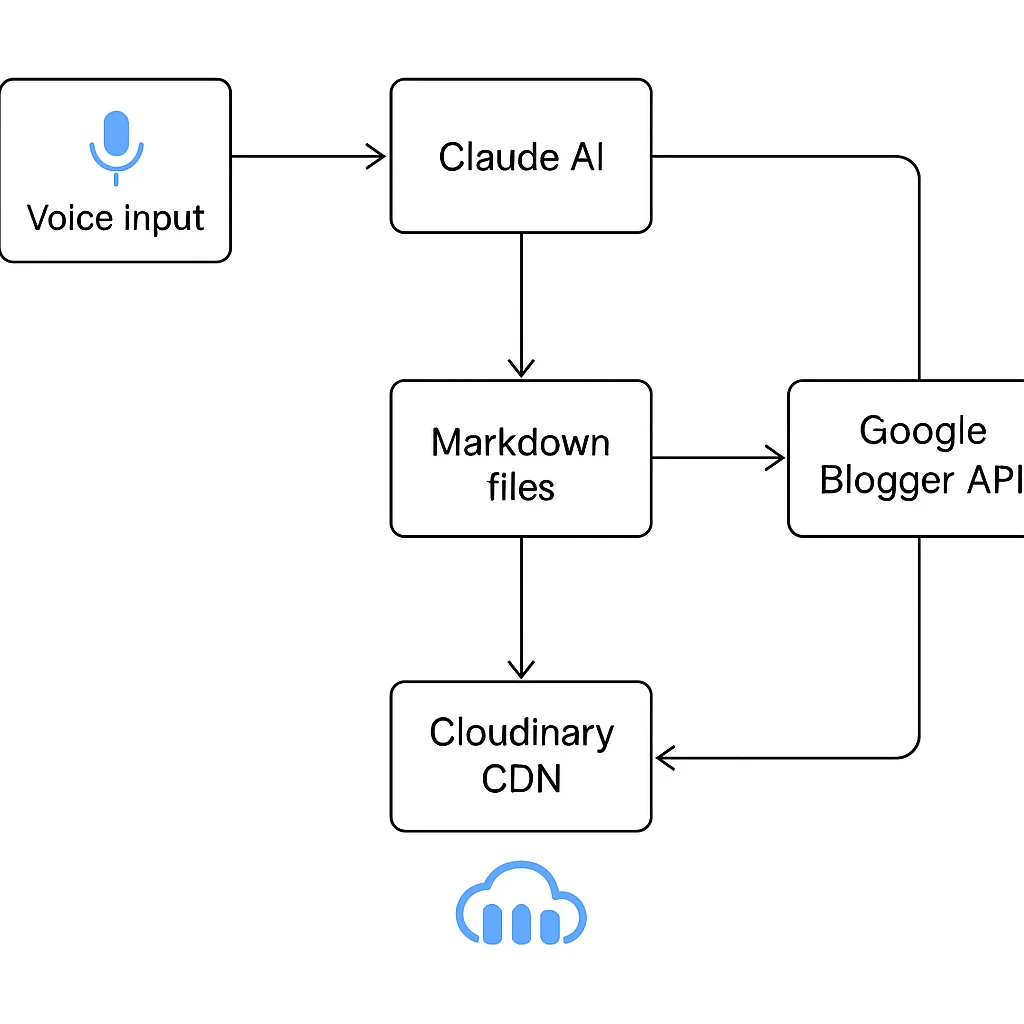Voice-to-Blog Automation with AI and Python

Hello World (But Make It Meta)
Welcome to my first blog post ever. And here's the thing: I built an entire blog automation system just so I could write this post.
I know that sounds backwards. Most people start a blog by writing "Hello World" in WordPress. I started by building a voice-to-published-blog pipeline powered by AI agents. Then I used it to write about itself.
Why? Because I kept putting off starting a blog. The friction was too high. Every time I had an idea, the thought of manually formatting markdown, finding images, configuring a blog platform, dealing with SEO... it killed the momentum before I even started.
So I did what any engineer does when procrastinating: I built a tool to automate the thing I was avoiding.
What I Built
Here's what I ended up with: A complete voice-to-published-blog pipeline that took me from zero to this post you're reading.
You literally just ramble about your idea—like you're explaining it to a friend at a coffee shop—and the system:
- ✅ Converts your rambling into a structured blog post
- ✅ Generates professional images with AI (OpenAI GPT-Image-1)
- ✅ Builds the HTML with syntax highlighting and formatting
- ✅ Runs SEO and quality checks automatically
- ✅ Uploads images to Cloudinary CDN
- ✅ Publishes to Google Blogger as a draft
- ✅ Updates instead of duplicating (it's idempotent!)
Then you review it, change status: draft to status: published, run one command, and you're live.
That's it. That's the whole workflow.
How It Works: The Four-Command Workflow
Here's the actual workflow I use now:
Step 1: Create the Post (Voice or Text)
I have a Claude Code slash command called /create-post. I just talk about my idea:
/create-post So today I made a really cool tech thing. It's for blogging. All I have to do is ramble about whatever I want to write about—I don't even have to structure it. The system takes my blurb, converts it into proper markdown, and even generates images for it...
Claude Code (powered by Anthropic's Sonnet) then:
- Analyzes my rambling and identifies the core story
- Chooses the best blog post format (tutorial, case study, listicle, etc.)
- Writes a complete, structured blog post in markdown
- Generates images automatically using the image generation tool
- Suggests detailed AI prompts for each image (hero images, diagrams, etc.)
- Saves everything to
posts/YYYY-MM-DD-slug/post.md
Here's the magic: the /create-post command doesn't just write text—it actively generates the images as part of the workflow. The command has access to the generate_image.py tool, so it crafts detailed prompts and creates the images while writing the post.
Step 2: Generate Images (If Needed)
If you want more images beyond what the command created, you can run:
uv run tools/generate_image.py "modern minimalist illustration of AI automation pipeline with voice input, markdown documents, and blog publishing, blue and purple gradient, clean tech aesthetic, isometric view, professional futuristic mood" posts/2025-10-12-my-post/hero.png
Each image costs about $0.015 (less than two cents) and looks way better than stock photos. We save the images directly in the post directory.
Step 3: Quality Check, Build, and Publish
With the post written and images generated, I run three more slash commands:
# Optional: Check quality (SEO + prose linting) /quality-check posts/2025-10-12-my-post/ # Validate and preview locally /build posts/2025-10-12-my-post/ # Publish to Blogger (creates draft) /publish posts/2025-10-12-my-post/
The /quality-check command runs both Vale prose linting and SEO analysis, catching issues like passive voice, wordy phrases, missing meta descriptions, and title length problems.
The /build command validates everything:
- Checks frontmatter and tag registry
- Validates image references
- Converts markdown to HTML with syntax highlighting
- Generates a local preview HTML file
The /publish command does the actual publishing:
- Uploads images to Cloudinary CDN (with hash-based deduplication)
- Converts markdown to HTML with Pygments syntax highlighting
- Detects if the post already exists (via directory path)
- Creates OR updates the post on Blogger (no duplicates!)
- Saves the
blogger_idback to frontmatter for future updates
When I'm ready to go live, I just change status: draft to status: published in the markdown and run /publish again. One command. Live blog post.
The Technical Stack
Here's what makes this work:
AI Content Generation
- Claude Code (Anthropic Sonnet 4.5) - Converts rambling to structured posts
- OpenAI GPT-Image-1 - Generates custom blog images from prompts
Content Pipeline
- Python 3.13 with
uvfor dependency management - Markdown → HTML conversion with Python-Markdown
- Pygments for code syntax highlighting
- YAML frontmatter for metadata (title, date, tags, status)
Infrastructure
- Cloudinary - Image CDN with automatic WebP conversion
- Google Blogger API - Publishing platform (with OAuth 2.0)
- Vale - Prose linting for readability and style
- Custom SEO checker - Validates title length, meta descriptions, headings, content length
Smart Features
- Idempotent publishing - Detects existing posts by directory path, updates instead of duplicating
- Hash-based image deduplication - Only uploads changed images to Cloudinary
- Tag registry - Enforced tag consistency (no tag sprawl!)
- Path-based URLs -
2025-10-12-hello-world→/2025/10/hello-world.html
The Architecture: How Everything Fits Together

Here's the flow:
- Voice/Text Input → Claude Code
/create-postcommand - AI Processing → Structured markdown + image prompts + frontmatter
- Image Generation → OpenAI API → Saved to post directory
- Build Step → Validates tags, converts markdown, generates preview HTML
- Quality Checks → SEO analysis + Vale prose linting (optional)
- Publish Step →
- Upload images to Cloudinary (if changed)
- Convert markdown to HTML with Pygments
- Create/update post via Blogger API
- Save
blogger_idto frontmatter
- Status Toggle → Change
draft→publishedand republish
Everything is idempotent—you can run commands many times safely. The system is smart enough to:
- Detect existing posts by directory name
- Only upload images when their hashes change
- Update instead of duplicate
- Preserve your
blogger_idacross runs
What This Actually Looks Like in Practice
Let me show you a real example. Here's my actual workflow for creating this exact post (my first blog post ever):
# 1. Talk about my idea (literally just rambled into Claude Code) /create-post So today I made a really cool tech thing... # 2. Claude wrote the post AND generated the images automatically! # 3. Optional: Run quality checks /quality-check posts/2025-10-12-voice-to-blog-automation/ # 4. Build and preview /build posts/2025-10-12-voice-to-blog-automation/ # 5. Publish as draft /publish posts/2025-10-12-voice-to-blog-automation/ # 6. Review on Blogger, then publish live # (Edit status: draft → published in post.md) /publish posts/2025-10-12-voice-to-blog-automation/
Total hands-on time: ~5 minutes (most of it reviewing the AI output—the images generated automatically!)
This is my first blog post ever. It took 5 minutes of actual work. The system I built to enable it took a day to build, but now the barrier to writing is gone.
Compare that to traditional blogging:
- Write in markdown editor: 45-60 minutes
- Find/create images: 20-30 minutes
- Format and optimize: 15-20 minutes
- Upload to blog platform: 10-15 minutes
- SEO checks: 10 minutes
Traditional first post: 2+ hours of friction. This approach: Build once, write forever in 5 minutes.
The Quality Checks: Making Sure It's Actually Good
One concern with AI-generated content: is it any good? Will it rank? Is it readable?
The /quality-check command runs two automated checks:
1. SEO Analysis
Checks for search optimization best practices:
- ✅ Title length (30-60 chars for Google)
- ✅ Meta description (150-160 chars)
- ✅ Heading structure (single H1, proper H2/H3 hierarchy)
- ✅ Content length (300+ words recommended)
- ✅ Image alt text
- ✅ Internal/external links
- ✅ Keyword density
Example output:
✅ Title length: 52 characters (optimal)
✅ Single H1 heading found
✅ Content length: 1,847 words
⚠️ Add meta description for search results
✅ 3 images with alt text
2. Prose Linting with Vale
Vale checks writing quality automatically:
- Passive voice detection
- Readability scores
- Clichés and weasel words
- Technical writing best practices
Example output:
12:34 suggestion 'really' is a weasel word write-good.Weasel
45:12 warning This sentence is too long write-good.TooWordy
You can ignore suggestions, but the system catches common mistakes before publishing. Run /quality-check on any post to get instant feedback.
Why This Matters: Starting Is the Hardest Part
Here's the truth: I'd been putting off starting a blog for years.
Not because I didn't have ideas. Not because I couldn't write. But because every time I thought about starting, I'd get overwhelmed by the setup:
- Pick a blogging platform
- Learn how to use it
- Figure out themes and styling
- Deal with image hosting
- Remember markdown syntax
- Manually publish and update
- Optimize for SEO
So I'd think "I'll do it later" and never actually start.
This automation system changed that. By building it, I removed every excuse I had. Now the barrier to writing is as low as talking. I went from years of procrastination to a published post in 5 minutes of actual writing.
What's Next?
I'm planning to add:
- Automatic social media posts (LinkedIn, Twitter) from blog content
- Voice-to-text input (literally just record audio, get blog post)
- Multi-platform publishing (Dev.to, Medium, Hashnode)
- Analytics integration (track what actually performs)
- Automated internal linking (connect related posts automatically)
What's Coming Next
This blog will dive deep into each piece of this automation pipeline—from setting up the Blogger API and OAuth flows, to building the markdown converter, to integrating Cloudinary for image optimization. I'll walk through the architecture decisions, the code, and the lessons learned along the way.
But here's where it gets even more interesting: adding an agentic layer on top.
Imagine the system automatically:
- Generating follow-up posts based on engagement metrics
- Creating social media threads from your blog content
- Suggesting related topics based on trending searches
- Autonomously maintaining and updating older posts
- Building internal link networks between related content
We're just scratching the surface of what's possible when you combine AI agents with content workflows.
Stay tuned for more. The future of content creation is autonomous, and we're going to build it together.
Conclusion: The Best Way to Start Is to Remove the Excuses
So this is my first blog post. Not a typical "Hello World," but a working system that made starting possible.
The irony isn't lost on me: I spent a day building automation to avoid spending 2 hours writing a blog post. But that's not really what happened. I spent a day removing the barrier that kept me from starting for years.
Now I have no excuses. The system is built. Writing takes 5 minutes. Publishing is one command.
If you've been putting off starting a blog (or any creative project), maybe you don't need motivation. Maybe you need to automate away the friction so that starting becomes the default instead of the exception.
This is post #1. Let's see how many more the automation makes possible.
Welcome to Agentic Engineer. Let's build things that make building things easier.